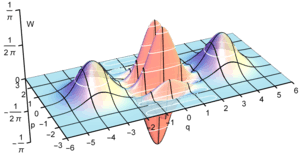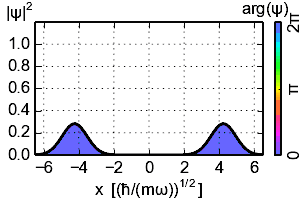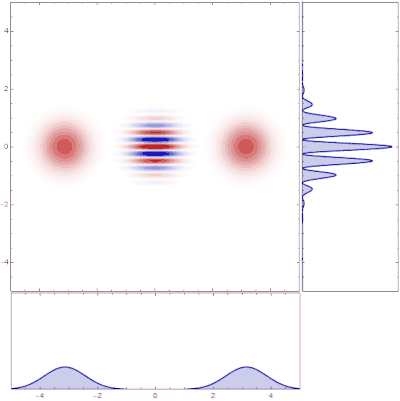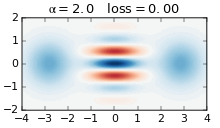Cat state
In quantum mechanics, the cat state, named after Schrödinger's cat,[1] is a quantum state that is composed of two diametrically opposed conditions at the same time,[2] such as the possibilities that a cat be alive and dead at the same time. Schrödinger's cat is sometimes connected to the many worlds hypothesis by its proponents.
Generalizing Schrödinger's gedanken experiment, any other quantum superposition of two macroscopically distinct states is also referred to as a cat state. A cat state could be of one or more modes or particles, therefore it is not necessarily an entangled state. Such cat states have been experimentally realized in various ways and at various scales.
Cat states over distinct particles
Concretely, a cat state can refer to the possibility that multiple atoms be in a superposition of all spin up and all spin down, known as a Greenberger–Horne–Zeilinger state (GHZ state), which is highly entangled. Such a state for six atoms was realized by a team led by David Wineland at NIST in 2005.[3]
Optically, the GHZ state can be realized with several distinct photons in a superposition of all polarized vertically and all polarized horizontally. These have been experimentally realized by a team led by Pan Jianwei at University of Science and Technology of China, for instance, four-photon entanglement,[4] five-photon entanglement,[5] six-photon entanglement,[6] eight-photon entanglement,[7] and five-photon ten-qubit cat state.[8]
This spin up/down formulation was proposed by David Bohm, who conceived of spin as an observable in a version of thought experiments formulated in the 1935 EPR paradox.[9]
Cat states in single modes



In quantum optics, a cat state is defined as the quantum superposition of two opposite-phase coherent states of a single optical mode (e.g., a quantum superposition of large positive electric field and large negative electric field):
- ,
where
- ,
and
- ,
are coherent states defined in the number (Fock) basis. Notice that if we add the two states together, the resulting cat state only contains even Fock state terms:
- .
As a result of this property, the above cat state is often referred to as an even cat state. Alternatively, we can define an odd cat state as
- ,
which only contains odd Fock states
- .
Even and odd coherent states were first introduced by Dodonov, Malkin, and Man'ko in 1974.[10]
Linear superposition of coherent states
A simple example of a cat state is a linear superposition of coherent states with opposite phases, when each state has the same weight:[11]
The larger the value of α, the lower the overlap between the two macroscopic classical coherent states exp(-2α2), and the better it approaches an ideal cat state. However, the production of cat states with a large mean photon number (=|α|2) is difficult. A typical way to produce approximate cat states is through photon subtraction from a squeezed vacuum state.[12][13] This method usually is restricted to small values of α, and such states have been referred to as Schrödinger "kitten" states in the literature. Methods have been proposed to produce larger coherent state superpositions through multiphoton subtraction,[14] through ancilla-assisted subtraction,[15] or through multiple photon catalysis steps.[16] Optical methods to "breed" cat states by entangling two smaller "kitten" states on a beamsplitter and performing a homodyne measurement on one output have also been proposed[17] and experimentally demonstrated.[18] If the two "kittens" each have magnitude then when a probabilistic homodyne measurement on the amplitude-quadrature of one beamsplitter output yields a measurement of Q=0, the remaining output state is projected into an enlarged cat state where the magnitude has been increased to [17][18]
Coherent state superpositions have been proposed for quantum computing by Sanders.[19]
Higher-order cat states
It is also possible to control the phase-space angle between the involved coherent amplitudes, so that they are not diametrically opposed. This is distinct from controlling the quantum phase relation between the states. Cat states with 3 and 4 subcomponents have been experimentally realized,[20] e.g., one might have a triangular cat state:
or a triangle superposed with vacuum state:
or a square cat state:
Decoherence

The quantum superposition in cat states becomes more fragile and susceptible to decoherence, the larger they are. For a given well-separated cat state (|α| > 2), an absorption of 1/|α|2 is sufficient to convert the cat state to a nearly-equal mixture of even and odd cat states.[21] For example with α = 10, i.e, ~100 photons, an absorption of just 1% will convert an even cat state to be 57%/43% even/odd, even though this reduces the coherent amplitude by only 0.5%. In other words, the superposition is effectively ruined after the probable loss of just a single photon.[22]
References
- John Gribbin (1984), In Search of Schrödinger's Cat, ISBN 0-552-12555-5, 22 February 1985, Transworld Publishers, Ltd, 318 pages.
- Dennis Overbye, "Quantum Trickery: Testing Einstein's Strangest Theory". New York Times Tuesday (Science Times), December 27, 2005 pages D1,D4.
- D. Leibfried, E. Knill, S. Seidelin, J. Britton, R.B. Blakestad, J. Chiaverini, D. Hume, W.M. Itano, J.D. Jost, C. Langer, R. Ozeri, R. Reichle, and D.J. Wineland. "Creation of a six atom 'Schrödinger cat' state". Nature. Dec. 1, 2005, 639–642.
- Zhao, Zhi; Yang, Tao; Chen, Yu-Ao; Zhang, An-Ning; Żukowski, Marek; Pan, Jian-Wei (2003-10-28). "Phys. Rev. Lett. 91, 180401 (2003) - Experimental Violation of Local Realism by Four-Photon Greenberger-Horne-Zeilinger Entanglement". Physical Review Letters. 91 (18): 180401. arXiv:quant-ph/0302137. doi:10.1103/PhysRevLett.91.180401. PMID 14611269.
- Pan, Jian-Wei; Briegel, Hans J.; Yang, Tao; Zhang, An-Ning; Chen, Yu-Ao; Zhao, Zhi (July 2004). "Experimental demonstration of five-photon entanglement and open-destination teleportation". Nature. 430 (6995): 54–58. arXiv:quant-ph/0402096. Bibcode:2004Natur.430...54Z. doi:10.1038/nature02643. PMID 15229594.
- Lu, Chao-Yang; Zhou, Xiao-Qi; Gühne, Otfried; Gao, Wei-Bo; Zhang, Jin; Yuan, Zhen-Sheng; Goebel, Alexander; Yang, Tao; Pan, Jian-Wei (2007). "Experimental entanglement of six photons in graph states". Nature Physics. 3 (2): 91–95. arXiv:quant-ph/0609130. Bibcode:2007NatPh...3...91L. doi:10.1038/nphys507.
- Yao, Xing-Can; Wang, Tian-Xiong; Xu, Ping; Lu, He; Pan, Ge-Sheng; Bao, Xiao-Hui; Peng, Cheng-Zhi; Lu, Chao-Yang; Chen, Yu-Ao; Pan, Jian-Wei (2012). "Observation of eight-photon entanglement". Nature Photonics. 6 (4): 225–228. arXiv:1105.6318. Bibcode:2012NaPho...6..225Y. doi:10.1038/nphoton.2011.354.
- Gao, Wei-Bo; Lu, Chao-Yang; Yao, Xing-Can; Xu, Ping; Gühne, Otfried; Goebel, Alexander; Chen, Yu-Ao; Peng, Cheng-Zhi; Chen, Zeng-Bing; Pan, Jian-Wei (2010). "Experimental demonstration of a hyper-entangled ten-qubit Schrödinger cat state". Nature Physics. 6 (5): 331–335. arXiv:0809.4277. doi:10.1038/nphys1603.
- Amir D. Aczel (2001), Entanglement: the unlikely story of how scientists, mathematicians, and philosophers proved Einstein's spookiest theory. ISBN 0-452-28457-0 Penguin: paperback, 284 pages, index.
- V.V. Dodonov; I.A. Malkin; V.I. Man'ko (15 March 1974). "Even and odd coherent states and excitations of a singular oscillator". Physica. 72 (3): 597–615. Bibcode:1974Phy....72..597D. doi:10.1016/0031-8914(74)90215-8.
- Souza, L.A.M.; Nemes, M.C.; Santos, M. França; de Faria, J.G. Peixoto (2008-09-15). "Quantifying the decay of quantum properties in single-mode states". Optics Communications. 281 (18): 4696–4704. arXiv:0710.5930. Bibcode:2008OptCo.281.4696S. doi:10.1016/j.optcom.2008.06.017.
- Ourjoumtsev, Alexei; Tualle-Brouri, Rosa; Laurat, Julien; Grangier, Philippe (2006-04-07). "Generating Optical Schrödinger Kittens for Quantum Information Processing". Science. 312 (5770): 83–86. Bibcode:2006Sci...312...83O. doi:10.1126/science.1122858. ISSN 0036-8075. PMID 16527930.
- Wakui, Kentaro; Takahashi, Hiroki; Furusawa, Akira; Sasaki, Masahide (2007-03-19). "Photon subtracted squeezed states generated with periodically poled KTiOPO4". Optics Express. 15 (6): 3568–3574. arXiv:quant-ph/0609153. Bibcode:2007OExpr..15.3568W. doi:10.1364/OE.15.003568. ISSN 1094-4087. PMID 19532600.
- Takeoka, Masahiro; Takahashi, Hiroki; Sasaki, Masahide (2008-06-12). "Large-amplitude coherent-state superposition generated by a time-separated two-photon subtraction from a continuous-wave squeezed vacuum". Physical Review A. 77 (6): 062315. arXiv:0804.0464. Bibcode:2008PhRvA..77f2315T. doi:10.1103/PhysRevA.77.062315.
- Takahashi, Hiroki; Wakui, Kentaro; Suzuki, Shigenari; Takeoka, Masahiro; Hayasaka, Kazuhiro; Furusawa, Akira; Sasaki, Masahide (2008-12-04). "Generation of Large-Amplitude Coherent-State Superposition via Ancilla-Assisted Photon Subtraction". Physical Review Letters. 101 (23): 233605. arXiv:0806.2965. Bibcode:2008PhRvL.101w3605T. doi:10.1103/PhysRevLett.101.233605. PMID 19113554.
- Miller Eaton, Rajveer Nehra, Olivier Pfister (2019-08-05). "Gottesman-Kitaev-Preskill state preparation by photon catalysis". arXiv:1903.01925v2 [quant-ph].CS1 maint: uses authors parameter (link)
- Lund, A. P.; Jeong, H.; Ralph, T. C.; Kim, M. S. (2004-08-17). "Conditional production of superpositions of coherent states with inefficient photon detection" (PDF). Physical Review A. 70 (2). doi:10.1103/PhysRevA.70.020101. ISSN 1050-2947.
- Sychev, D.V., Ulanov, A.E., Pushkina, A.A., Richards, M.W., Fedorov, I.A. and Lvovsky, A.I., 2017. Enlargement of optical Schrödinger's cat states. Nature Photonics, 11(6), p.379.
- Sanders, Barry C. (1992-05-01). "Entangled coherent states". Physical Review A. 45 (9): 6811–6815. Bibcode:1992PhRvA..45.6811S. doi:10.1103/PhysRevA.45.6811. PMID 9907804.
- Vlastakis, B.; Kirchmair, G.; Leghtas, Z.; Nigg, S. E.; Frunzio, L.; Girvin, S. M.; Mirrahimi, M.; Devoret, M. H.; Schoelkopf, R. J. (2013). "Deterministically Encoding Quantum Information Using 100-Photon Schrodinger Cat States" (PDF). Science. 342 (6158): 607–610. doi:10.1126/science.1243289. ISSN 0036-8075.
- Glancy, Scott; de Vasconcelos, Hilma Macedo (2008). "Methods for producing optical coherent state superpositions". Journal of the Optical Society of America B. 25 (5): 712. arXiv:0705.2045. doi:10.1364/JOSAB.25.000712. ISSN 0740-3224.
- Serafini, A; Siena, S De; Illuminati, F; Paris, M G A (2004). "Minimum decoherence cat-like states in Gaussian noisy channels" (PDF). Journal of Optics B: Quantum and Semiclassical Optics. 6 (6): S591–S596. doi:10.1088/1464-4266/6/6/019. ISSN 1464-4266.